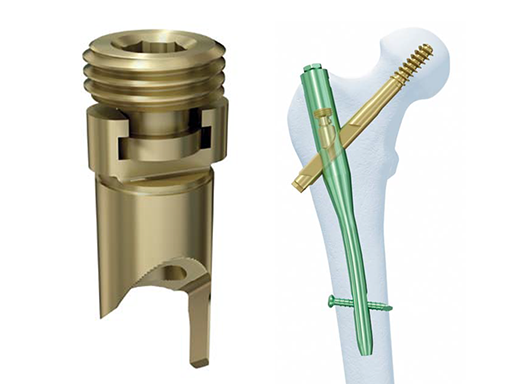
TFN Set Screw
The development of the TFN Set Screw (Fig 1) is a solution for helical blade or screw migration after fracture fixation in the proximal femur and subsequent postoperative collapse of the femoral head element.
If a surgeon wants to prevent sliding, the scrub technician has to remove the TFN locking mechanism from inside the nail and replace it with the pre-assembled TFN Set Screw. The surgeon must make a conscious decision to replace the locking mechanism with the TFN Set Screw which helps to ensure that the surgeon does not unintentionally prevent sliding.
Self-retention between sub-components of the TFN Set Screw allows for ease of insertion. After the head element is inserted, the surgeon will use a torque limiting handle to tighten the set screw and prevent collapse. If the surgeon changes his or her mind and wants to allow sliding, the tang is long enough that the set screw can be backed off to allow sliding, while still preventing rotation. If sliding is permitted, however, an end cap must be used in conjunction with the set screw.
It is important to note that the TFN Set Screw should only be used for fixation in fractures where sliding of the head element is not desired. The addition of the locking feature expands the utility of the TFN system. While it should only be used in select cases, the new locking feature offers an alternative fixation option for certain difficult and complex fractures.
Hazards and labeling
Due to varying countries’ legal and regulatory approval requirements, consult the appropriate local product labeling for approved intended use of the products described on this website. All devices on this website are approved by the AO Technical Commission. For logistical reasons, these devices may not be available in all countries worldwide at the date of publication.
Legal restrictions
This work was produced by AO Foundation, Switzerland. All rights reserved by AO Foundation. This publication, including all parts thereof, is legally protected by copyright.
Any use, exploitation or commercialization outside the narrow limits set forth by copyright legislation and the restrictions on use laid out below, without the publisher‘s consent, is illegal and liable to prosecution. This applies in particular to photostat reproduction, copying, scanning or duplication of any kind, translation, preparation of microfilms, electronic data processing, and storage such as making this publication available on Intranet or Internet.
Some of the products, names, instruments, treatments, logos, designs, etc referred to in this publication are also protected by patents, trademarks or by other intellectual property protection laws (eg, “AO” and the AO logo are subject to trademark applications/registrations) even though specific reference to this fact is not always made in the text. Therefore, the appearance of a name, instrument, etc without designation as proprietary is not to be construed as a representation by the publisher that it is in the public domain.
Restrictions on use: The rightful owner of an authorized copy of this work may use it for educational and research purposes only. Single images or illustrations may be copied for research or educational purposes only. The images or illustrations may not be altered in any way and need to carry the following statement of origin “Copyright by AO Foundation, Switzerland”.
Check www.aofoundation.org/disclaimer for more information.
If you have any comments or questions on the articles or the new devices, please do not hesitate to contact us.
“approved by AO Technical Commission” and “approved by AO”
The brands and labels “approved by AO Technical Commission” and “approved by AO”, particularly "AO" and the AO logo, are AO Foundation's intellectual property and subject to trademark applications and registrations, respectively. The use of these brands and labels is regulated by licensing agreements between AO Foundation and the producers of innovation products obliged to use such labels to declare the products as AO Technical Commission or AO Foundation approved solutions. Any unauthorized or inadequate use of these trademarks may be subject to legal action.
AO ITC Innovations Magazine
Find all issues of the AO ITC Innovations Magazine for download here.
Innovation Awards
Recognizing outstanding achievements in development and fostering excellence in surgical innovation.





